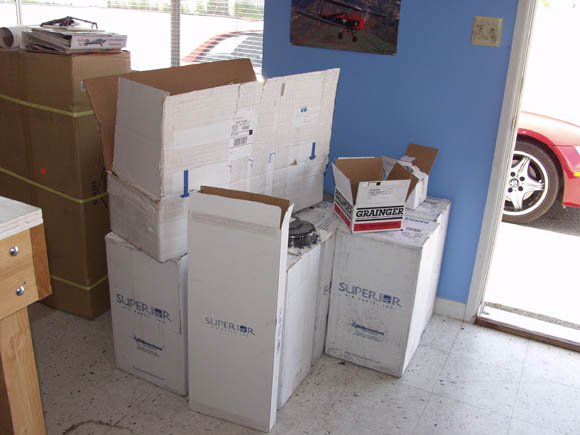The overhauler checks in the parts, and then you tell them what you want in terms of services. I wanted the standard overhaul and inspections, lapping and line boring of the case, and dynamic balance on the crank. In my case I took the case, accessory pads and drives, crank, rods, pushrods, rocker arms, and engine geartrain. I decided on all-new cylinders and top end parts, and on a new camshaft, so all the old stuff stayed in Seattle.
ECI offers not only overhaul service but also makes new parts including O-470 cylinders. I decided not to go with ECI but instead to buy Superior cylinders, mostly because my mechanic has had good experiences with Superior parts in the past.
After the parts are dropped off you get to wait for the inspections to be completed, and you hold your breath on certain things like whether your case is cracked or your crank is out of limits dimensionally (bent, worn too far undersize, etc).
The overhauler will clean all the parts, which is why you shouldn't let your mechanic torture you with excessive cleanup after disassembly (some people find amusement by making you do this!). The overhauler then inspects with non-destructive techniques such as Magnaflux for steel parts and dye-penetrant for aluminum, as well as dimensional inspection. Lastly, any rework that is necessary will be done, such as installing new bushings, polishing bearings, welding case cracks, and lapping and line bearing on the case halves. The overhauler will usually perform any factory service bulletins that have come out since your engine was last overhauled, but to be sure you should always ask the overhauler and your mechanic about what bulletins apply.
For my engine, the case was in good shape, the crank had some minor scoring on the flange that needed to be polished and replated, and the counterweights were no good and had to be replaced with serviceable used parts. All in all nothing major. In the worst case you could get hit with case cracks and repairs, case warpage that's out of limits, or a bad crankshaft due to excessive wear. If your crank is no good it gets very expensive.
Five or six weeks after taking your parts in, you can pick them up and fondle the shiny clean pieces. In return for your check you'll also get a wad of paperwork certifying the airworthiness of the overhauled parts.
In the meantime, you should keep yourself busy by accumulating all of the new parts and consumables you're going to need for disassembly. This is where the parts book comes in handy. I ordered all new cylinder kits from Superior (which include valves and pistons), piston pins, a new camshaft, through bolts, a few miscellaneous parts such as the generator drive pulley that got bent during removal, a major overhaul gasket and seal kit, engine mount vibration isolators, front seal, oil pressure relief springs, and any other hardware you want to replace. The list of 100% replacement parts can be found in the overhaul manual. All of this stuff arrived a few weeks later.

Lastly, there's accessory overhaul which also takes a few weeks depending on the overhauler. I scattered accessories to Galvin Flying Service in Seattle, the hydraulic pump to Flightcraft in Portland, and the propeller governor to Wings West in Puyallup. Again everything comes back all shiny and clean.